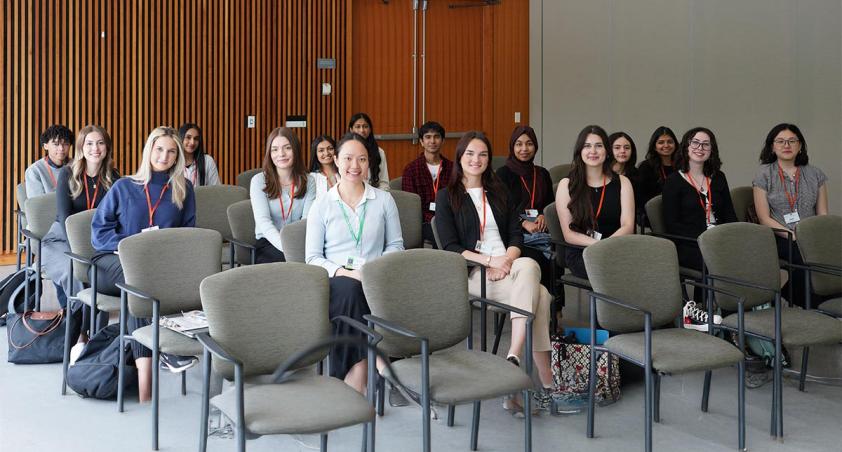19th Annual Anne & David Ward Family Summer Student Research Day
Each summer, the Ward Family Summer Student Research Program attracts students from universities from all over Canada to collaborate alongside some of the brightest minds in childhood disability and developmental differences research in the world.
These budding young scientists are embedded in Bloorview Research Institute's research labs such as the Autism Research Centre, EPIC lab, PROPEL lab and the PRISM Lab to help researchers unlock a world of possibilities for children and youth with disabilities.
This year, 17 of the best and brightest undergraduate and medical students were selected for this prestigious program from over 1,200 applications coast to coast. This group includes students from the SOAR (Sparking student Opportunities for Advancing inclusive childhood disability Research) stream within the summer student research program. This specialty stream is made possible through a partnership between the Bloorview Research Institute and the Community of Support-Research Application Support Initiative (COS-RASI), an initiative administered by the University of Toronto’s Temerty Faculty of Medicine. This initiative provides learners from under-represented communities with mentorship and support at various stages of their research career journey.
The final highlight of the program will be an opportunity for these talented students to highlight their research at the 19th annual Anne & David Ward Family Summer Student Research Day on Tuesday, July 22nd, 2025.
This event will be held in-person in the Holland Bloorview Conference Centre and Coriat Atrium and live streamed over Zoom Webinar.
This year's award winners are:
- Tiffany Chong, winner of the Best Research Poster
- Ghazal Rafeeh, winner of the Best Quick Hits Presentation
- Salony Sharma, winner of the Best Research Presentation
Congratulations to all the winners and to all of the Ward summer students!
The Ward Family Summer Student Research Program is made possible through The Ward Family Foundation, Holland Bloorview Foundation donors and the Bloorview Research Institute.
| Time | Agenda Item |
| 9:00 – 9:30 a.m. | Registration (Light refreshments provided) |
| 9:30 – 9:45 a.m. | Welcome Remarks |
| 9:45 – 10:10 a.m. | Quick Hit Presentations – Round 1 (6 presentations) |
| 10:10 – 10:40 a.m. | Research Talks + Q&A – Round 1 (3 presentations) |
| 10:40 – 10:55 a.m. | Morning Break (Light refreshments provided) |
| 10:55 – 11:15 a.m. | Quick Hit Presentations – Round 2 (5 presentations) |
| 11:15 – 11:45 a.m. | Research Talks + Q&A – Round 2 (3 presentations) |
| 11:45 a.m. – 12:15 p.m. | Lunch break (Light snacks provided) |
| 12:15 – 1:15 p.m. | Poster Presentations (Coriat Atrium) – Guests are welcome to have their meals while browsing [in-person only] |
| 1:15 – 1:45 p.m. | Keynote Address + Q&A: Dr. Imran Khamis, PhD Scientific Liaison, FDC Foundation [in-person only] |
| 1:45 – 2:15 p.m. | Award Ceremony & Closing Remarks |
| 2:15 p.m. | Program ends |

Talk title: Beyond the PhD: Where personal growth meets lasting impact
Biography: Imran Khamis is the Scientific Liaison for FDC Foundation, a private family foundation based in Mississauga, Ontario. FDC Foundation focuses on helping improve patient outcomes through funding research, education and innovation. Imran’s roles include the translation of scientific information for the rest of his team and building meaningful relationships with key members of the scientific & medical community; this ensures that FDC Foundation is making the most informed funding decisions while also bringing added value to the donor-donee partnership.
He earned his PhD in Molecular Biology from the University of Waterloo, successfully defending his research-based thesis in 2017.
Ward Student Profiles
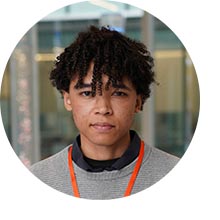
University and Program: University of British Columbia - Biomedical Engineering
Supervisor and Lab: Dr. Jan Andrysek
Bio: Arthur is going into his third year of biomedical engineering at the University of British Columbia. He hopes to specialize in biomechanics and cellular engineering. He is currently working at the PROPEL lab at Holland Bloorview, where he hopes to learn more about prosthetics design and gait analysis. In the future, he would like to study neural engineering.
Project Title: Evaluating the accuracy and reliability of smartphone photogrammetry for scanning residual limbs.
Background: Traditional shape capture for orthotic and prosthetic (O&P) devices relies heavily on the experience of the practitioner. To reduce this dependency, 3D scanners are being introduced, but their use in hospitals is limited by accessibility challenges. Smartphone photogrammetry, creating a 3D model from photos, has recently been proposed as a method to circumvent these challenges. However, there is minimal research on its accuracy or reliability, particularly for upper limb prosthetics.
Objective: To evaluate the accuracy, intra- and inter-rater reliability of three smartphone-based photogrammetry applications, compared to 3D scanners, for scanning transradial residual limbs.
Methods: To test the accuracy, objects will be scanned using each application and compared to an advanced structured-light scanner (EinScan 3D, Shining Technologies, China) in terms of volume and Cartesian dimensions. The intra- and inter-rater reliability will be determined by scanning the same object three times and having two people scan the same object, respectively.
Results: Preliminary results show that majority of the applications achieved a dimension difference of less than 4% or less than 2mm, and a volume difference of less than 5%. Studies have found that these differences are small enough to be clinically acceptable (Ngan et al., 2022; Hernandez, Lemaire, 2016).
Conclusion: Smartphone photogrammetry may be viable for residual limb scanning, but more research is needed using residual limbs.
Relevance to Holland Bloorview Clients & Families: If successful, clients may eventually have their limb scanned at home, reducing the need to travel to a prosthetist.
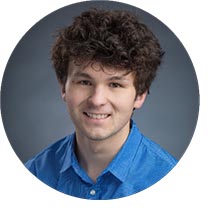
University and Program: University of Toronto, Medicine
Supervisor and Lab: Dr. Evdokia Anagnostou
Bio: Basile Favel is a 2nd year medical student studying at the University of Toronto's Temerty Faculty of Medicine. Prior to starting Medical School, Basile attained an undergraduate degree in Cognitive Sciences from McGill University and worked as an educator in Nunavik and Nunatsiavut. Basile is interested in exploring autism neurodevelopment and the social determinants that shape neurodiverse lives. In his free time Basile enjoys reading, road cycling, and rock climbing.
Project Title: Examining the Impact of Diagnostic Timing on Quality of Life in Autistic Individuals.
Background: Autism Spectrum Disorder is a neurodevelopmental condition that can be reliably diagnosed by age 2–3, yet many children face delays in identification. While earlier diagnosis is linked to better developmental outcomes, delayed diagnosis may exacerbate emotional and social difficulties, impacting overall well-being. Despite this, the direct relationship between age at diagnosis and long-term quality of life (QoL) remains underexplored.
Research Question: Among autistic children aged 4–17, is age at diagnosis associated with quality of life, as measured by total scores on the KINDL-R questionnaire at multiple time points throughout their development?
Methods: Nonlinear regression models will be used to assess the association between age of autism diagnosis and quality of life, as measured by the KINDL-R questionnaire. Key covariates (e.g. sex, socioeconomic status, autism symptom severity) will be included based on prior evidence of their relevance to QoL outcomes in neurodivergent populations.
Results: We expect to find that a later age of autism diagnosis will be associated with lower KINDL-R total scores, indicating reduced quality of life. This relationship is anticipated to remain significant after adjusting for key covariates.
Conclusions: The goal of this study is to determine to what extent the age at which an individual is diagnosed with Autism has an impact on their future quality of life.
Relevance to Clients & Families: Early autism diagnosis may play a key role in promoting long-term emotional and social well-being for autistic youth and their families.

University and Program: McMaster University, Life Sciences
Supervisor and Principal Investigator: Dr. Jan Andrysek and Dr. De-Lawrence Lamptey
Bio: Bhumika Rahulan is entering her fourth year of the Honours Life Sciences program at McMaster University. She has a strong interest in health research, particularly projects with direct patient impact that aim to improve quality of life. At Holland Bloorview, she is contributing to pediatric health research and hopes to advance knowledge in this area. During this Summer she is especially interested in learning more about children’s experiences with mobility challenges and how innovative solutions can support their independence. In the future, she aspires to continue making a meaningful difference in patients’ lives.
Project Title: The Global Impact of the COVID-19 Pandemic on the Educational Experiences of Racialized and Non-Western Children and Adolescents with Disabilities and Their Families: A Scoping Review
Background: Racialized and non-Western children with disabilities face systemic educational barriers. The COVID-19 pandemic exacerbated these disparities, particularly with the shift to online learning. However, global reviews on its impact remain limited.
Research Question: How did the COVID-19 pandemic impact the educational experiences of racialized and non-Western school-aged children and adolescents with disabilities and their families globally?
Methods: Medline, CINAHL, PsycINFO, EMBASE, Google Scholar, and OpenGrey were searched for global studies from 2019 onward. Two independent reviewers screened 48 articles. 34 focused on educational experiences, and findings were extracted and synthesized from these.
Results: Key themes included technological barriers, such as limited devices and internet access, which disproportionately affected low-income families and hindered online learning. Education depended heavily on parents, especially challenging for essential workers. Many children lost access to school services, including special education, and received few accommodations due to inaccessible, non-tailored resources, causing skill regression.
Conclusion: Racialized and non-Western children and adolescents with disabilities faced widespread inadequate education during the pandemic. Further research is needed to develop long-term strategies for inclusive, equitable, and accessible education in virtual and in-person settings.
Relevance to Holland Bloorview Clients and Families: These findings can guide policies and programs to reduce pandemic-related educational impacts on racialized clients and recent migrants from non-Western countries, enhancing access to quality education and support for children with disabilities.
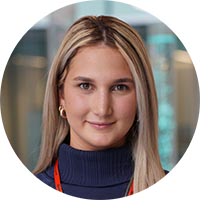 University and Program: McMaster University, Integrated Science, Interdisciplinary Minor in Latin American & Latinx Studies
University and Program: McMaster University, Integrated Science, Interdisciplinary Minor in Latin American & Latinx Studies
Supervisors and Lab: Dr. Melanie Penner
Bio: Gabriela is entering her fourth year at McMaster University in the Integrated Science (iSci) Program, with an Interdisciplinary Minor in Latin American & Latinx Studies. She is deeply passionate about advocating for those whose voices are often overlooked in STEM and health studies research. Her work at Holland Bloorview will be focused on evaluating and improving systems of care and diagnosis for children with disabilities in Ontario. Gabriela aspires to become a pediatrician and help research move towards advancements that are inclusive for all children with disabilities.
Project Title: Understanding Supports and Barriers to Autism Diagnosis by Community Health Care Providers in Canada: A Qualitative Study Using the Theoretical Domains Framework
Background: In Canada, the demand for autism diagnosis is growing. However, current provincial models often fail to meet this demand, leaving families in most regions facing extensive wait times. Timely diagnosis is critical for access to resources and funding. Community health care providers (HCPs) can often conduct diagnostic assessments; however, they are often unable to do so due to various barriers, including provincial policies and norms.
Research Question: What facilitators and barriers do community HCPs face when conducting autism diagnostic assessments across five Canadian provinces?
Methods: This qualitative study draws on data from focus groups/interviews with 23 community pediatricians who provide care in one of the five provinces in the ECHO (Extension for Community Healthcare Outcomes) AuDIO (Autism Diagnosis and Integrated care Opportunities) study. Two researchers collaboratively coded the data using a deductive approach to ensure consistency with the Theoretical Domains Framework (TDF), which includes 14 domains identifying behavioral factors influencing diagnostic practices. The first author then conducted a reflexive thematic analysis using an inductive approach to generate belief statements and themes aligned with TDF domains.
Results: Preliminary results in Ontario suggest the domains influencing community HCPs to perform autism diagnostic assessments are environmental context and resources, skills, and social/ professional role and identity.
Conclusions: These findings will be used to formulate community-based toolkits and implementation strategies that will help HCPs feel confident conducting diagnostic assessments.
Relevance to Holland Bloorview Clients & Families: An autism diagnosis marks an early point of a journey filled with unknowns for many Holland Bloorview families. Understanding the role of HCPs allows targeted solutions that enable timely diagnoses.
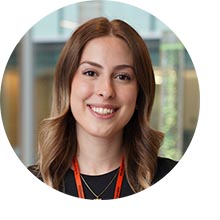
University and Program: Queen's University, Life Sciences Specialization
Supervisor and Lab: Dr. Danielle Baribeau
Bio: Ghazal is entering her fourth year of a Life Sciences specialization degree at Queen’s University. She will be completing her undergraduate thesis in the upcoming year, focusing on cardiovascular imaging and disease. Her previous research has explored risk stratification for major adverse cardiovascular events, as well as the use of virtual reality interventions for managing chronic pain and anxiety. Her current research at Holland Bloorview focuses on the genetic predispositions of Autism Spectrum Disorder with Dr. Danielle Baribeau. Her two years of volunteer experience at Holland Bloorview has deepened her passion for advancing research in this field.
Project Title: The prevalence, impact, and utility of rare genetic diagnoses among children with physical disabilities and/or neurodevelopmental disorders (NDDs) receiving care in a tertiary pediatric rehabilitation program.
Background: Rare genetic disorders are increasingly identified in pediatric populations with physical disabilities and NDDs. Genome wide sequencing approaches are now considered a first line investigation for children diagnosed with autism and medical complexity.1 However, the utilization of clinical genetic testing varies greatly by both population and setting.
Research Question: In a population of children with physical disabilities and/or NDDs attending follow-up visits in a tertiary pediatric rehabilitation program, 1) what proportion have undergone genetic testing and been diagnosed with a genetic condition, and 2) how frequently has the genetic diagnosis added clinical utility regarding care planning?
Methods: We are conducting a retrospective chart review of up to 674 children aged ≤18 years with physical neurodisabilities who have been seen for follow-up in the Neuromotor clinic at Holland Bloorview. Available clinical practice guidelines will be reviewed alongside clinic notes to determine whether the genetic diagnosis added clinical utility to the patient’s care plan, or whether there was a missed opportunity to do so.
Results: A preliminary analysis was conducted on data collected from 73 patients. Among these patients, 32 (44%) had a positive genetic test result, and 22 of those (69%) had clinical practice guidelines associated with their diagnosis. The genetic diagnoses added clinical utility regarding referrals or investigations in 11 children (34%), treatment in 5 (16%), and natural history in 20 (62%), with missed referral or investigation opportunities in 4 (12%).
Relevance to Holland Bloorview Clients & Families: By identifying the contribution of genetic diagnoses to clinical utility, this study will help guide the development of innovative genetic care for this population of children at Holland Bloorview.
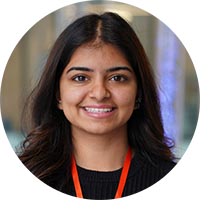
University and Program: University of Toronto, Life Sciences, Human Biology and Psychology Major
Supervisor and Lab: Dr. Danielle Baribeau
Bio: Jiya is an undergraduate psychology student at the University of Toronto Scarborough with a passion for pediatric mental health and neurodevelopment. Her past research at St. Michael’s Hospital focused on traumatic brain injury, and cognitive functioning. She is excited to contribute to the current research at Holland Bloorview exploring psychopharmacology in children with neurodevelopmental differences, including autism and rare genetic conditions. She also supports children with ADHD and autism through her tutoring role. She hopes to learn more about individualized interventions in pediatric mental health and the role of early supports in developmental outcomes.
Project Title: Comparison of clinical profiles among children with and without rare genetic conditions followed in a tertiary pediatric rehabilitation program
Background: Rare genetic conditions are increasingly identified in children with neurodevelopmental disorders (NDDs) and physical disabilities such as cerebral palsy. These conditions often contribute to complex clinical profiles involving multiple co-occurring conditions and diverse presenting symptoms, including developmental, behavioral, feeding, sleep, and mental health challenges. Greater insight into these profiles may enhance care planning, interdisciplinary collaboration, and targeted family support.
Research Question: Among children receiving care through a tertiary pediatric rehabilitation program, how do complex clinical profiles, including co-occurring conditions and presenting symptoms of concern, differ based on genetic testing status and presence or absence of a genetic condition?
Methods: We are conducting a retrospective chart review of up to 674 children and youth (≤18 years) followed in the neuromotor program at Holland Bloorview Kids Rehabilitation Hospital. Clinical data on co-occurring conditions (e.g., developmental delays, behavioral issues, sleep disturbances, feeding/growth concerns, and mental health challenges) are being extracted from medical records. Participants are grouped by genetic testing status: (1) rare genetic condition identified, (2) tested with no condition identified, and (3) not tested. Descriptive and univariate analyses (e.g., chi-square, Wilcoxon rank-sum tests) will examine patterns across groups.
Results: Data collection is ongoing. Preliminary analysis of 73 charts analyzed indicated that 32 (43%) patients had been identified with a genetic condition, 18 (24%) had been tested with a negative result, and 22 (30%) had not had genetic testing. Additional analyses with an expanded sample size are in process and will be reported among completion.
Relevance to Holland Bloorview Clients & Families: Understanding how rare genetic conditions relate to complex clinical profiles can help families and care teams anticipate needs, advocate for services, and make timely referrals to specialized supports and genetic counseling at both local and provincial levels.
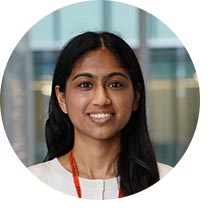
University and Program: McMaster University, Biochemistry
Supervisor and Lab: Dr. Evdokia Anagnostou
Project Title: Understanding recommendations to policy, practice, and removal of barriers to enhance the experiences of youth with disabilities from minoritized groups
Bio: Navreen graduated from McMaster University this year with a Bachelor of Health Sciences in Biochemistry. Her previous research at McMaster University focused on the detection of Vascular Endothelial Growth Factor (VEGF) using a versatile electrochemical biosensor assay. Her current research at Holland Bloorview focuses on exploring physical and mental health in Neurodivergent children and youth. She hopes to deepen her understanding of pediatric health, neurodiversity and inclusive research methods to better support children’s well-being in both clinical and community settings.
Project Title: Physical health across neurodivergent children and youth in Ontario
Background: Neurodevelopmental disorders (NDDs) are being increasingly recognized for their association with physical health conditions (PHC). However, existing limited research has focused on ASD, neglecting how PHC may manifest across different diagnoses.
Research Question: What are the transdiagnostic and potentially diagnosis-specific patterns and prevalence of physical health conditions in children aged 3-21 with NDD and control participants in the POND cohort, and how do age, sex at birth, and sociodemographic factors influence these associations?
Methods: 3 to 21 years old participants in the POND cohort completed a form at baseline to assess any prior PHCs. Descriptive statistical analysis will determine the point prevalence of each RMQ category across NDD diagnoses and control participants. A series of ANOVA tests will be conducted to adjust for age, sex at birth, and various sociodemographic factors. Finally, a multivariate regression analysis will be performed.
Results: Preliminary analyses of control data demonstrate a statistically significant difference in PHC prevalence by sex at birth and family income, with ADHD and autism prevalence decreasing from Q1 to Q5 (X2 = 972.07; p = < 2.2e-16) and (X2 = 3696; p = < 2.2e-16), respectively.
Conclusions: While disease prevalence varies based on sex at birth and income, further analyses will determine whether these results apply transdiagnostically.
Relevance to Holland Bloorview Clients & Families: An understanding of co-occurring PHCs helps to guide healthcare sectors, such as Holland Bloorview and clinicians, to provide more comprehensive, individualized care and support, to improve the quality of life for youth and families with childhood-onset disabilities.
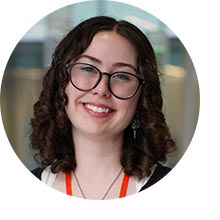
University and Program: McMaster University – Health Sciences (Honours), Child Health Specialization
Supervisor and Lab: Dr. Sarah Munce
Bio: Persephone is entering her fourth year of the Bachelor of Health Sciences (Honours) program at McMaster University, specializing in Child Health. Her previous research has focused on patient-informed outcomes in pediatric rehabilitation and the psychosocial impact of chronic conditions. She has volunteered with Holland Bloorview since 2023 and is excited to begin her time at the Bloorview Research Institute. This summer, she will conduct a secondary analysis of qualitative data on pediatric-to-adult healthcare transitions to update an empirical model of compassionate care. She is eager to advance research that integrates the voices of children, families, and clinicians in health care.
Project Title: Adapting the empirical model of compassion for pediatric-to-adult health care transitions
Background: Compassion is frequently referenced as an important aspect of quality healthcare, yet limited research incorporates the perspectives of those most impacted: patients and caregivers. Sinclair’s Empirical Model of Compassion conceptualizes compassion as a virtuous response to suffering through relational understanding and action. A scoping review identified factors associated with compassion in pediatric healthcare, including continuity, communication, and coordination of care. These factors are important aspects of healthcare transitions, a period marked by fragmentation, confusion, and emotional burden.
Research Question: What is the relevance of Sinclair’s model of compassion in the context of the transition from the pediatric-to-adult healthcare system from the perspective of youth with childhood-acquired disabilities and their caregivers?
Methods: A secondary analysis was conducted on semi-structured interviews exploring transitions from pediatric-to-adult rehabilitation and community services among youth with childhood-acquired disabilities (n = 12) and their caregivers (n = 5). Reflexive thematic analysis, following Braun and Clarke’s approach, was used to analyze data inductively and deductively.
Results: Findings will be used to adapt Sinclair’s Empirical Model of Compassion in the context of healthcare transitions. Preliminary analysis indicates compassionate care is demonstrated through healthcare provider virtues of beneficence, respect, and patience, and through receptive communication and action.
Conclusions: The resulting model offers a patient- and caregiver-informed framework for understanding compassion in pediatric-to-adult healthcare transitions.
Relevance to Holland Bloorview Clients & Families: This model identifies key domains of compassionate transitional care, providing a foundation to develop meaningful quality indicators and targeted interventions to improve transitions.
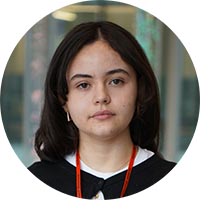
University and Program: University of Toronto, Cellular and Molecular Neuroscience & Applied Statistics
Supervisor and Principal Investigator: Dr. Jacob Ellegood
Bio: Rafaela is pursuing an Honours Bachelor of Science in Cellular and Molecular Neuroscience with a minor in Applied Statistics at the University of Toronto. She recently completed her second year of undergraduate study. At Holland Bloorview, her research involves analyzing clinical MRI datasets to investigate how structural differences in the brain may relate to behaviour across developmental disorders. She also contributed to a systematic review of artificial intelligence models for clinical prediction in healthcare, where she gained experience evaluating models and synthesizing findings. Rafaela is interested in how brain circuits involved in emotion, memory, and the regulation of conflicting emotional signals develop over time and intends to build on these interests through graduate-level research.
Project Title: ADHD Subtypes and Internalizing Symptoms Modulate Region-Specific Brain Lateralization
Background: Atypical hemispheric asymmetry is common in ADHD and ASD, particularly in large-scale regulatory networks like the default mode, cingulo-opercular, and frontostriatal systems 1-3. ADHD subtypes, Inattentive (ADHD-I) and Combined (ADHD-C), differ clinically, with evidence of subtype-specific alterations in lateralized prefrontal and cingulate regions 4-6. Internalizing symptoms, more common in ADHD-I 4-7, may influence asymmetry in mood-relevant areas, though their developmental basis remains unclear. Understanding these interactions may clarify subtype-specific abnormalities and inform more personalized interventions.
Research Question: Does ADHD subtype predict differences in hemispheric asymmetry and regional brain volume in lateralized regulatory networks? Do these relationships change based on comorbid internalizing symptoms?
Methods: Structural MRI data from ADHD and ASD patients aged 10–18 years were obtained from the Province of Ontario Neurodevelopmental network, where subtype was measured with the SWAN scale and Anxiety and Depression with RCADS. Asymmetry Index (AI) was calculated, with positive scores indicating leftward asymmetry8. Linear models were used to test Subtype × Anxiety and Depression interactions on AI and volume. Post hoc slopes identified effect direction within subtypes.
Results: Significant Subtype x RCAD scores interactions were found in the opercular inferior frontal gyrus (p = .040), triangular inferior frontal gyrus (p = .043), and medial orbital superior frontal gyrus (p = .047), with higher RCAD scores associated with increased leftward asymmetry in the Inattentive group only (b = 0.113, 0.103, and 0.113; p < .05). While, in the superior parietal gyrus (p = .032), this effect was specific to the Combined group (b = 0.160, p < .05).
Conclusions: Internalizing symptoms interacted with ADHD subtype to predict asymmetry in frontoparietal networks, with increased prefrontal asymmetry in ADHD-I and parietal in ADHD-C. These patterns reflect subtype-specific disruptions in how hemispheric specialization develops 5, 9-10 likely shaped by emotional comorbidity affecting attentional and affective control systems 11-12. Further analysis should incorporate functional metrics and age interactions.
Relevance to Holland Bloorview Clients & Families: These findings may help improve intervention accuracy by accounting for a child’s ADHD subtype and co-occurring anxiety or depression
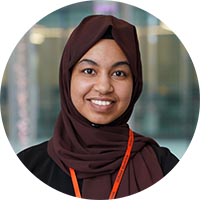
University and Program: University of Guelph, Bio-Medical Science
Supervisor and Lab: Dr. Jacob Ellegood
Bio: Reem recently graduated from the University of Guelph with an Honours Bachelor of Science in Bio-Medical Science. She aspires to pursue medicine and is particularly interested in pediatrics. At Holland Bloorview’s Autism Research Centre, her work focuses on MRI-based research exploring neurodevelopmental heterogeneity in children. Reem has supported patient populations as a hospital volunteer and pharmacy assistant. She hopes to integrate her academic and clinical experiences to better understand and support children with neurodevelopmental conditions.
Project Title: The interaction of socioeconomic status and race/ethnicity in predicting whole-brain volumes among children ≤18 with neurodevelopmental disorders in the POND Network cohort
Background: Despite Canada’s increasing diversity, health disparities remain a pressing issue in Ontario. This study examines how socioeconomic status (SES) and race/ethnicity jointly influence brain development in children with neurodevelopmental disorders (NDDs). Existing research is largely U.S.-centric, often investigates SES or race/ethnicity in isolation, and focuses primarily on autism spectrum disorder, highlighting a gap in intersectional, transdiagnostic neuroimaging research in Canadian pediatric populations.
Research Question: To what extent do SES and race/ethnicity interact to predict whole-brain volumes among children aged ≤18 with NDDs?
Methods: Data from 789 children with transdiagnostic NDDs (e.g., ADHD, ASD, OCD) from the Province of Ontario Neurodevelopmental Disorders (POND) Network were analyzed. Whole-brain volumes were calculated from ComBat-harmonized MRI data. SES, measured by household income, and race/ethnicity were parent-reported. A multiple linear regression model examined associations between whole-brain volume and SES, race/ethnicity, their interaction, age, and sex.
Results: The full model was statistically significant (p < 2.2e-16); age was a significant negative predictor (p = 6.26e-06). Main effects of SES and race/ethnicity were non-significant, but their interaction was marginally significant (p = 0.04–0.09), suggesting race/ethnicity may influence how income relates to whole-brain volume. Adjusted R² = ~16.5%.
Conclusions: These findings provide early evidence that intersecting social determinants may impact neurodevelopment, contributing to equity-informed pediatric neuroimaging.
Relevance to Holland Bloorview Clients & Families: As Canada’s largest pediatric rehabilitation hospital located in diverse Toronto, HB supports this project’s equity mission. HB’s commitment to socially accountable care and its core value of IDEAA (Inclusion, Diversity, Equity, Accessibility, and Anti-Racism) directly aligns with the goals of this research.
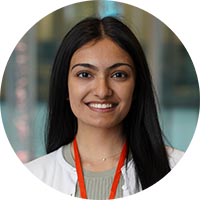
University and Program: Queen’s University, Health Sciences
Supervisor and Lab: Dr. Laura McAdam
Bio: Salony recently completed her third year of Health Sciences at Queen’s University and looks forward to starting medical school at McMaster University this fall. Salony’s interest in the diverse determinants of youth health has inspired her involvement in research analyzing adolescent vaping habits, the intergenerational impact of parental incarceration, and student mental health during COVID-19, alongside her contributions to national cohort studies examining child health behaviours. Beyond her research, Salony has enjoyed founding a non-profit music lesson program for children and leading the delivery of health literacy workshops in local schools. At Holland Bloorview, she supports research focused on children with neuromuscular conditions.
Project Title: Bullying experiences of youth with neuromuscular conditions: Youth and Parent Perspectives
Background: Bullying is an epidemic for Canadian youth. However, its impact on the social lives of youth with neuromuscular conditions may not be fully captured by caregivers. Parental intervention is protective against bullying; questions remain about how youth and parental perceptions of bullying align.
Research Question: Does bullying and quality of life perception between youth with neuromuscular conditions and their parents differ?
Methods: Twenty-two youth-parent dyads (youth: Meanage=14.1 years, 81.8% male) completed a survey about youth bullying experiences (type, frequency, motive) and quality of life (KIDSCREEN-10). Dyad agreement was assessed using percent agreement (PA), Cohen’s Kappa (κ), and response difference (Meandiff). κ closer to +1.0 reflects stronger agreement; Meandiff>0 indicates youth endorsed items more than parents.
Results: Seventy-seven percent of youth (n=17) and 86.4% of parents (n=19) reported youth were bullied at some point in their life (PA=72.7%; κ=.753, p<.001). Physical bullying saw strong agreement (PA=90.9%; κ=.919, p<.001); verbal (PA=59.1%; κ=.801, p<.001) and social (PA=50.0%; κ=.521, p=.014) bullying presented discrepancies. Youth experiences with disability-motivated bullying exceeded parental perception (PA=36.4%; Meandiff=.227). Youth reported greater quality of life than parents predicted (PA=0.0%; Meandiff=7.15). Parents overestimated loneliness experienced (PA=0.0%; κ=-.262, p<.001; Meandiff=-1.86) and underestimated number of friendships (PA=28.6%; Meandiff=3.62).
Conclusions: Discrepancies arose across experiences of bullying, loneliness, and number of friendships, with analyses indicating youth and parents view quality of life differently.
Relevance to Holland Bloorview Clients & Families: This work promotes family-centered care that navigates prioritizing a client’s direct report, drawing on parental insight, or integrating both. For families, this may prompt conversations about psychosocial experiences, especially when parents are proxy advocates.
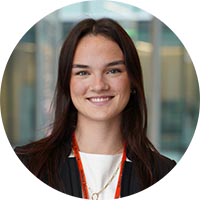
University and Program: McMaster University, Electrical and Biomedical Engineering
Supervisor and Lab: Dr. Tom Chau
Bio: Samantha recently completed her third year in Electrical and Biomedical Engineering at McMaster University. With a background in competitive sports, and having coached gymnastics for five years, she developed a passion for working with children. Samantha is excited about combining her engineering knowledge with this passion to help children live fulfilling lives through applied technology and innovation.
Project Title: Evaluation of a P300 BCI for functional communication in children with disabilities
Background: Brain-computer interface (BCI) technology is a promising approach for communication for individuals with severe motor impairments. P300 BCIs rely on visual stimulus to evoke an event-related potential (ERP) in a participant’s EEG activity, that is recognized by a BCI. However, its efficiency for functional communication applications in children with disabilities is under researched.
Research Question: Can visual P300 BCIs facilitate functional communication in children with motor impairments?
Methods: Thirteen participants, aged 5 to 19, with limited speech and motor function, were recruited for up to 5 sessions. Each session consisted of multiple trials where participants were instructed to visually focus on a target button with a cartoon picture. Buttons were flashed in a random order to trigger P300 ERPs, which were subsequently used to predict which button the participant was visually focused on. If the predicted button matched the target, a YouTube video was played as a reward. Eye gaze data was recorded simultaneously to track each participant’s visual attention.
Results: Two participants displayed a strong P300 ERP in response to the flashing target button. For the remaining participants, analysis of the participant’s eye gaze data suggests that there was a lack of visual attention on the target button.
Conclusions: This study provides preliminary evidence supporting the feasibility of a P300 BCI for communication in children with disabilities who retain good visual attentiveness. Further research into addressing the lack of visual attention and improving participant engagement is needed.
Relevance to Holland Bloorview Clients and Families: Study outcomes seek to expand the set of technologies available to children and families seeking alternative communication methods.
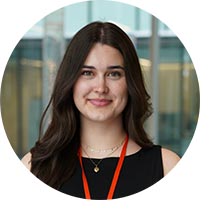
University and Program: Queen's University, Biology and Psychology
Supervisor and Lab: Dr. Tom Chau
Bio: Selina Chalmers is an undergraduate student at Queen’s University completing her HBSc in Biology and Psychology. She works as a research assistant in both an attentional dynamics lab and a cognitive neuroscience lab, gaining hands-on experience with eye-tracking, MRI, and biosensing technologies. Her research interests include cognitive and computational neuroscience, and she aspires to pursue graduate studies focused on exploring and advancing neurotechnology. This summer, she will gain hands-on experience working with brain-computer interface (BCI) technology through a research placement at Holland Bloorview, allowing her to apply her skills in a real-world setting and contribute to innovative cutting-edge research.
Project Title: Towards Multimodal BCIs for Access: A Performance and Usability Comparison of Individual Modalities
Background: Individuals with cerebral palsy (CP) often face significant barriers due to the limitations of current access technologies. Physiological signals, such as muscle (EMG), eye (EOG), and brain (EEG) signals have independently been investigated as novel access methods, but each faces its own limitations1. Few studies directly compare these modalities within the same users; this study fills that gap by evaluating usability and performance to inform a multi-signal hybrid interface that overcomes these barriers.
Research Question: How do EOG, EMG, and EEG modalities compare in terms of usability - measured through effectiveness, efficiency, and user satisfaction - in both adults and children?
Methods and Analysis: This study involved 24 neurotypical participants (16 adults, 8 children), each of whom used EEG, EMG, and EOG signals to control a computer game. Afterwards, participants answered a usability questionnaire that collected their subjective experience with each modality. Usability differences across modalities were assessed using ANOVA and Post hoc tests. Classification accuracy, precision, and recall was used to assess the objective performance of each modality.
Results: Results indicated significant differences across modalities, with motor imagery (MI/EEG) rated as the most mentally demanding and least effective (p < .001), while EMG was perceived as the most accurate and intuitive, especially in adults. Children required more strategy assistance with EMG (p = .011), highlighting age-specific trade-offs. Overall, adults performed equally well with EMG and EOG, while EEG was notably lower; for children, performance was highest with EMG, followed by EOG, and then EEG.
Conclusion: This work is critical for advancing assistive technologies tailored to individuals with CP. Further efforts will focus on developing a hybrid interface that is more accessible, accurate, and reliable.
Relevance to Holland Bloorview Clients and Families: This project is committed to supporting families and empowering individuals with CP through inclusive, accurate, user-driven innovation.
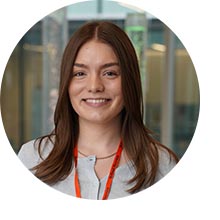
University and Program: University of Toronto, Neuroscience and Psychology
Supervisor and Lab: Dr. Shannon Scratch
Bio: Sophie is graduating this June from the University of Toronto with a HBSc in Neuroscience and Psychology. She will be working in the NOvEL lab this summer, focusing on active rehabilitation for persistent post-concussion symptoms. Previously, she has worked at the Minnesota Tic and Compulsivity Lab, focusing on implementing TMS as a supplement to Comprehensive Behavioural Intervention for Tics. Additionally, she volunteers as a clinical research trainee in the SickKids Emergency Department, enrolling participants and collecting data for various studies. In the future, she hopes to pursue graduate studies in Neuropsychology. She is looking forward to learning more about the impacts of TBI on children and further developing her research skills at Holland Bloorview.
Project Title: Examining Caregiver Motivation and Engagement in Move&Connect-Caregivers: A multi-source exploration
Background: Move&Connect-Caregivers1 (M&C-C) is a virtual group-based intervention for caregivers of youth experiencing persisting post-concussion symptoms (PPCS). This study examines factors driving caregiver motivation and engagement, important contributors to intervention outcomes.
Research Question: Based on multi-source data, what motivates caregivers of youth with PPCS to join and remain engaged in M&C-C, and how do they engage with the intervention?
Methods: Nine M&C-C groups were delivered, each over six weekly sessions. Participants included 34 caregivers aged 35–63 (M=48.7). Most caregivers (n=27; 82%) identified as women. Attendance and participation data were summarized descriptively. Directed content analysis was applied to survey responses, field notes, and interviews. Pre-identified codes were drawn from motivation2 and engagement3 frameworks, with inductive coding capturing additional insights.
Results: Preliminary analysis indicates high attendance, with 73% (n=22) completing at least five sessions. Each participant received a participation rating for each session attended; 83% were classified as excellent, indicating meaningful group contributions and reflections. Qualitative findings identified caregiver motivation as intrinsic, extrinsic, or mixed, and engagement as cognitive, affective, or behavioural. Common motivational factors included seeking connections and learning strategies to support themselves and their child. Caregivers engaged through belief in M&C-C, emotional connection, and active participation.
Conclusions: High attendance, strong participation, and diverse motivational and engagement patterns indicate that the program fosters a supportive environment that promotes sustained involvement. Ongoing analysis will identify key contributors to engagement in M&C-C.
Relevance to Holland Bloorview Clients & Families: Understanding factors that promote caregiver motivation and engagement in M&C-C may enhance outcomes for families with PPCS and inform strategies to strengthen engagement across pediatric rehabilitation programs.
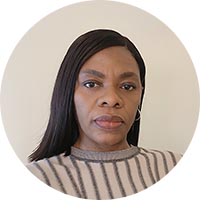
University and Program: Laurentian University, Psychology
Supervisor and Lab: Dr. De-Lawrence Lamptey
Bio: Stella will graduate from Laurentian University in June this year with a Bachelor of Arts in Psychology. In the fall, she will commence her Master's in Applied Psychology, also at Laurentian University. For her undergraduate thesis, she examined how the reality television show, Love on the Spectrum, constructs and communicates meaning about the dating abilities of autistic youths. Her research at Holland Bloorview focuses on the intersectionality of childhood disability and racial identity /ethnicity. Stella is excited to broaden her knowledge and research abilities on autism and family adaptations to neurodevelopmental disorders.
Project Title: COVID-19 and Children with Disabilities: Experiences of Racialized and Non-Western Families in Accessing Disability Services.
Background: Globally, the COVID-19 pandemic weakened access to disability services for families of children with disabilities, thus altering their family conditions. Yet little research has explored the experiences of racialized and Non-Western families.
Research Question: What were the experiences of racialized and non-Western families in accessing disability services during the pandemic?
Methods: A scoping review was conducted across four electronic databases and two grey literature sources from 2019 onward. Two independent reviewers identified 48 out of 2201 articles meeting the inclusion criteria. Guided by intersectionality and ecological systems theory, thematic analysis identified three central themes: Disability Service Disruptions, Telehealth Experiences and Family Dynamics.
Results: Disability service disruptions led to delays, halts, or suspensions of therapies such as Botox, Physiotherapy, and OT. Telehealth experiences varied across families with reports of affordability, convenience, and digital challenges. Family dynamics revealed increased bonding and parental support in some families, while other families experienced increased conflict and stress.
Conclusions: The mixed findings highlight the need for policies and resources that ensure equitable and sustained access to disability services across racialized and non-western families in pandemic-like situations.
Relevance to Holland Bloorview Clients & Families: This study can inform the service delivery and accessibility for diverse families and children, including newcomers and immigrant families. For instance, equipping them with digital literacy, technology, and emotional resilience workshops to navigate future crises.
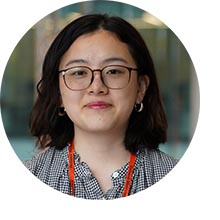
University and Program: University of Waterloo, Psychology
Supervisor and Lab: Dr. Tim Ross and Dr. Melanie Penner
Bio: Tiffany is entering her third year at the University of Waterloo for a Bachelor of Arts in Psychology. Her previous research experience has centered on social and developmental psychology, but she is also passionate about improving healthcare access for those who are neurodivergent, have disabilities, or are from minority backgrounds. This summer, her research with Drs. Ross and Penner aims to explore how physicians’ understandings of disability affect how they treat their patients. She is grateful for this opportunity and hopes to attend graduate school to reduce barriers in the healthcare and educational systems for underprivileged children and their families.
Project Title: Exploring the relationship between language and ableism in case formulations of disabled children
Background: Physicians are at the forefront of disabled children’s care. Their written impressions influence how these children and their families will be perceived by future professionals involved in their care. Although studies have examined physicians' explicit ableism, they have not explored how it can manifest in patient care via documentation practices and discourses.
Research Question: How do physicians’ conceptualizations of childhood disability influence their language use in first-visit case formulations of disabled children?
Methods: We examined case formulations from 375 charts of first-visit patients aged 0-19 years old from January 2019 to March 2025 from 3 clinics at Holland Bloorview. We sampled across sex/gender and age ranges. Each chart’s ‘Impressions’ or ‘Summary’ section was transcribed, thematically coded, and analyzed using a critical discourse analysis approach.
Results: Preliminary analyses highlight three key themes: (1) assumptions about the value of disabled childhoods, (2) The use of patronizing and ‘othering’ language, and (3) differences in documentation depending on clinic, physician experience and child age.
Conclusions: Initial analyses suggest ableism is a subtle yet pervasive theme in medical documentation. The use of patronizing language and medical jargon in case formulations can undermine the patient-family-physician relationship and lower overall quality of care.
Relevance to Holland Bloorview Clients & Families: Our study will encourage clinicians to reflect on the power they (and their documentation) hold in determining how disabled children are perceived in healthcare, education, and social systems.
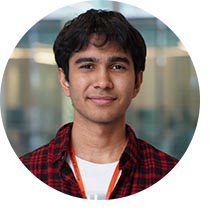
University and Program: McMaster University, Software and Biomedical Engineering
Supervisor and Lab: Dr. Tom Chau
Bio: Zuhair has completed his second year in the Software and Biomedical Engineering program at McMaster University. Over the past few years, he has gained diverse research experience, including projects focused on developing biological tools to track Alzheimer's disease progression and on characterizing sociodemographic correlates of adaptive functioning in neurodiverse children. He is eager to further explore the applications of software and data science to neurological research and eventual therapeutic development, especially in care for vulnerable populations.
Project Title: Validating a multiuser brain-computer interface for investigating interbrain synchronization during a shared recreational robotic control activity.
Background: Social interaction during shared tasks often involves neural coordination between individuals, a phenomenon termed interbrain synchronization. Prior studies have shown that recreational robotic activities increase social interaction, yet their impact on interbrain synchronization remains underexplored. Multiuser brain-computer interface (mBCI) technologies offer a promising approach to shared control of devices, allowing simultaneous decoding and recording of neural activity. This study investigates the feasibility of a shared, goal-oriented, visual imagery task for mBCI-based robot control in eliciting interbrain synchronization.
Research Question: Can a shared visual imagery-based robotics task elicit interbrain synchronization in a participant pair?
Methods: A participant pair wearing electroencephalography (EEG) headsets was tasked with imagining the movement of a robot for 5 seconds, alternating with 5-second rest periods for 40 offline trials and 40 online trials. EEG data was collected, filtered, and preprocessed. Average powers in distinct frequency bands across frontal and occipital channels were extracted to validate robot control via mBCI. To measure synchrony, phase-locking values (PLVs) during visual imagery were averaged across trials between different cortical regions in participants. PLVs closer to 1 indicate higher synchrony.
Results: At least one classifier per participant achieved practical accuracy (70%) in distinguishing visual imagery states from rest states. Preliminary analysis of average PLVs suggests a possibility of higher synchronization in central and frontal and central and posterior brain regions during visual imagery.
Conclusions: The mBCI system can enable reliable shared control of a robot through visual imagery. There is also promising evidence for neural coordination during visual imagery, although further sessions are needed for confirmation.
Relevance to Holland Bloorview Clients & Families: mBCI technology overcomes traditional social interaction barriers in shared activities, facilitating the inclusion of clients with complex communication needs and their families in recreational contexts.
